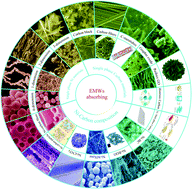Opportunities and challenges in microwave absorption of nickel–carbon composites
Abstract
In recent years, the problem of electromagnetic wave (EMW) pollution has attracted more and more attention with the development of science and technology. In order to solve this complex problem, the research and development of EMW-absorbing materials is crucial. The new absorbing materials should have the characteristics of light weight, high efficiency, wide bandwidth, environmental protection, oxidation resistance, and other characteristics. Traditional single-phase Ni materials exhibit remarkable ferromagnetic behavior and double-loss mechanisms (dielectric loss and magnetic loss), and are considered as efficient EMW absorbers. However, under the action of EMWs, especially in the GHz frequency band, Ni materials tend to produce an eddy current effect, which limits their application prospects. For Ni-based materials, there is much interest in modifying the composite materials by designing a hierarchical structure for their preparation. Traditional, single-phase, carbon-based materials have been widely used in related fields because of their light weight and good conductivity. However, a single-loss mechanism will affect the impedance matching of carbon materials, thus affecting their application in the field of absorbing waves. For carbon materials, people use them as a filler or matrix material to fabricate composites with metals, metal oxides, or polymer materials to obtain carbon-containing absorbing materials. This paper reviews the evaluation and design principles of the absorbing properties of EMW-absorbing materials. Then, the progress of modified single-phase Ni-based materials (designed materials with 0D, 1D, 2D, and 3D structures), the development of carbon materials (carbon black, carbon nanotubes, carbon fiber, graphite oxide, reduced graphene oxide, and biomedical carbon), and the research progress of Ni–C composite materials (the composite material formed by nickel and carbon) are reviewed. The ultimate goal is to obtain absorbers with light weight, strong absorbing ability, and a wide frequency band. In particular, Ni-MXene, Ni-biomedical carbon, and Ni-multiphase carbon composites are the target direction for designing new and high efficiency EMW absorbers. Finally, the basic challenges and opportunities in this field are discussed.

- This article is part of the themed collection: PCCP Perspectives


 Please wait while we load your content...
Please wait while we load your content...